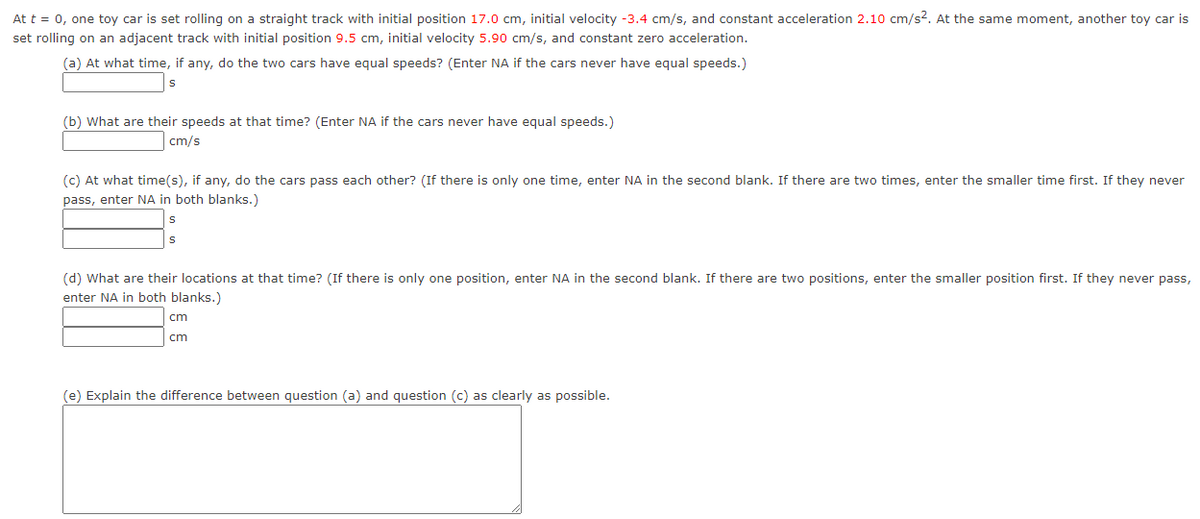At t = 0, one toy car is set rolling on a straight track with initial position 17.0 cm, initial velocity -3.4 cm/s, and constant acceleration 2.10 cm/s?. At the same moment, another toy car is set rolling on an adjacent track with initial position 9.5 cm, initial velocity 5.90 cm/s, and constant zero acceleration. (a) At what time, if any, do the two cars have equal speeds? (Enter NA if the cars never have equal speeds.) (b) What are their speeds at that time? (Enter NA if the cars never have equal speeds.) cm/s (c) At what time(s), if any, do the cars pass each other? (If there is only one time, enter NA in the second blank. If there are two times, enter the smaller time first. If they never pass, enter NA in both blanks.) (d) What are their locations at that time? (If there is only one position, enter NA in the second blank. If there are two positions, enter the smaller position first. If they never pass, enter NA in both blanks.) cm cm
At t = 0, one toy car is set rolling on a straight track with initial position 17.0 cm, initial velocity -3.4 cm/s, and constant acceleration 2.10 cm/s?. At the same moment, another toy car is set rolling on an adjacent track with initial position 9.5 cm, initial velocity 5.90 cm/s, and constant zero acceleration. (a) At what time, if any, do the two cars have equal speeds? (Enter NA if the cars never have equal speeds.) (b) What are their speeds at that time? (Enter NA if the cars never have equal speeds.) cm/s (c) At what time(s), if any, do the cars pass each other? (If there is only one time, enter NA in the second blank. If there are two times, enter the smaller time first. If they never pass, enter NA in both blanks.) (d) What are their locations at that time? (If there is only one position, enter NA in the second blank. If there are two positions, enter the smaller position first. If they never pass, enter NA in both blanks.) cm cm
Principles of Physics: A Calculus-Based Text
5th Edition
ISBN:9781133104261
Author:Raymond A. Serway, John W. Jewett
Publisher:Raymond A. Serway, John W. Jewett
Chapter3: Motion In Two Dimensions
Section: Chapter Questions
Problem 5OQ: Does a car moving around a circular track with constant speed have (a) zero acceleration, (b) an...
Related questions
Question

Transcribed Image Text:At t = 0, one toy car is set rolling on a straight track with initial position 17.0 cm, initial velocity -3.4 cm/s, and constant acceleration 2.10 cm/s2. At the same moment, another toy car is
set rolling on an adjacent track with initial position 9.5 cm, initial velocity 5.90 cm/s, and constant zero acceleration.
(a) At what time, if any, do the two cars have equal speeds? (Enter NA if the cars never have equal speeds.)
(b) What are their speeds at that time? (Enter NA if the cars never have equal speeds.)
cm/s
(c) At what time(s), if any, do the cars pass each other? (If there is only one time, enter NA in the second blank. If there are two times, enter the smaller time first. If they never
pass, enter NA in both blanks.)
(d) What are their locations at that time? (If there is only one position, enter NA in the second blank. If there are two positions, enter the smaller position first. If they never pass,
enter NA in both blanks.)
cm
cm
(e) Explain the difference between question (a) and question (c) as clearly as possible.
Expert Solution
This question has been solved!
Explore an expertly crafted, step-by-step solution for a thorough understanding of key concepts.
This is a popular solution!
Trending now
This is a popular solution!
Step by step
Solved in 5 steps

Recommended textbooks for you

Principles of Physics: A Calculus-Based Text
Physics
ISBN:
9781133104261
Author:
Raymond A. Serway, John W. Jewett
Publisher:
Cengage Learning

Principles of Physics: A Calculus-Based Text
Physics
ISBN:
9781133104261
Author:
Raymond A. Serway, John W. Jewett
Publisher:
Cengage Learning